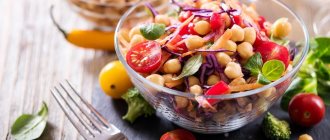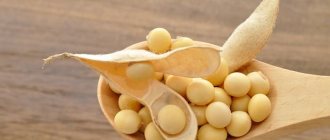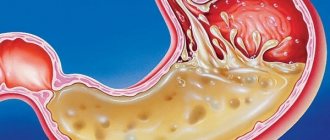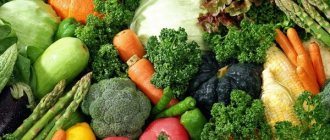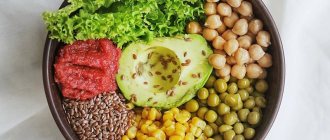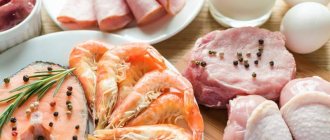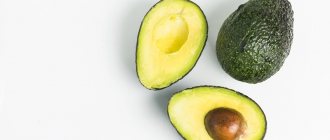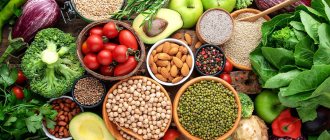In this article we will talk about so-called negative calorie foods. You will find out whether it is a myth or truth, whether such products really help with weight loss. Also in the article we will provide a table with a list of such products.
Before writing this article, I carefully studied many sources and several studies on this topic and found out whether there really is such a miraculous weight loss effect from negative calorie foods? Opinions vary, but let's try to find the truth.
Negative calorie concept
Foods that are consumed raw or cooked while preserving their beneficial properties, vitamins and minerals, when they enter the stomach, force them to spend more calories on their digestion than they contain themselves.
Negative calories do not contribute to weight gain, speed up metabolism, stabilize the functions of the digestive tract, and improve overall well-being.
Their beneficial nutritional properties are that they do not provide extra calories and contain a lot of water and fiber, which fill the stomach and dull the feeling of hunger.
Are low-calorie foods always good for you?
Harmony is when all the calories that enter the body are consumed and there is no remainder. A person's need for energy depends on many factors. Here is their list:
- age and gender;
- weight;
- Kind of activity;
- health status;
- climatic living conditions.
Low-calorie foods are needed for those who are overweight and want to lose weight. During heavy physical work, active sports training, during recovery after surgery and growth, the body needs a lot of calories.
A large amount of energy is spent on heating the body in winter, which is especially important for harsh regions. The need for kcal increases by 15-25% during pregnancy and breastfeeding.
The physiological norm for men is considered to be 2100-4200 kcal per day, for women it is 1800-3050 kcal
Lack of energy will cause a person to be lethargic and unable to concentrate.
For a child’s body, this is fraught with delays in mental and physical development. If a person is malnourished, then he does not receive vital elements: amino acids, unsaturated fats, glucose, vitamins and minerals. This leads to the development of diseases. Therefore, any restrictions must be reasonable.
The main misconceptions of those who want to lose weight
1. Food with negative energy can be combined with fatty dishes , since it is able to bind and block fat, preventing it from being absorbed, but simply being removed from the body along with waste products.
Vegetables, berries and fruits cannot prevent the entry of cholesterol and fats into the body. Junk food is difficult to digest. The secreted fat, which exceeds the body's needs, accumulates in the form of extra pounds deposited on the buttocks, waist, and hips.
Excess cholesterol that appears due to uncontrolled eating of fats is especially dangerous. Fried, oily foods are one of the causes of cholesterol plaques on the heart and blood vessels.
2. Negative calories burn fat. There is no need to waste time on diets and sports activities. To bring yourself back to normal, you just need to eat exclusively vegetables and fruits for a few weeks.
Low-calorie foods promote quick satiety, improve digestion and metabolism, but cannot destroy previously accumulated kilograms. Correctly selected physical training, a balanced diet, and massage will help you cope with excess weight. In severe cases, medications may be prescribed to normalize weight.
3. By eating only fruit and vegetable foods, you can eliminate extra pounds , remove fat folds, restore and maintain health.
This hypothesis is denied by nutritionists. In addition to liquid, natural microcellulose, antioxidants and enzymes of natural origin, the body vitally needs cellular polymers, organic compounds of animal nature, polyunsaturated acids contained in meat and fish products.
Refusal of carbohydrate-protein foods will undoubtedly help eliminate extra pounds, but will create a deficiency of nutrients and energy required for the normal functioning of cells. As a result of such nutrition, the body will be harmed.
This diet negatively affects not only absolutely healthy people, but is also simply dangerous for people with dysfunction of the pancreas, liver, and gastrointestinal tract. Vegetarianism is strictly contraindicated for children . The lack of organic nutrition can provoke a delay in the growth and development of a child, become the basis for the appearance of pathologies of internal organs and systems, and disrupt metabolism.
Zero Calorie Drinks
In addition to foods, there are also drinks where the calorie content tends to zero. Drinking green tea and water requires 40 to 70 kcal to process.
It’s not for nothing that green tea is considered a fat-burning drink. To achieve this goal, you should drink only green tea without any additives. No sugar, milk or honey should be added to the drink. In summer it is better to drink iced tea, and in winter - hot. Temperature does not affect the effectiveness of the drink. It is necessary to choose real green tea; a low-quality variety will not bring the desired result. One cup burns up to 60 kcal; you are allowed to consume no more than 5 cups per day. Regular use of green tea improves the functioning of the heart, blood vessels and stomach.
Ordinary reading water will also help burn fat. A non-carbonated drink with ice has the ability to burn from 50 to 70 kcal. The recommended volume per day is about 2 liters. Water is the drink of life, since with its help the body removes waste, toxins and harmful particles from the breakdown of fats. You should always drink water, not just when dieting. In addition to water and green tea, it is allowed to drink still water (low salt) and freshly squeezed juices from natural vegetables and fruits.
Rating of food products with negative calorie content
Rating of the most popular low-energy foods:
- Green vegetables: cucumbers, zucchini, celery, onions of all kinds, white cabbage, radish, garden spinach, green beans.
- Red root vegetables: beets, regular and cherry tomatoes, carrots, radishes, bell peppers, pumpkin.
- Fruits: orange, lemon, tangerines, nectarines, pineapples, plums, quince, pears.
- Berries: blueberries, wild strawberries, red and black currants, cranberries, serviceberry, blueberries, watermelon.
- Mushrooms of any variety.
- Seaweed.
- Greens and herbs: dill, arugula, cilantro, basil, parsley, lettuce, mint.
- Any spices that help digestion: cinnamon, saffron, nutmeg, oregano, curry, black pepper.
- Drinks: still mineral water, green tea, coffee, freshly squeezed juices.
Particular care should be taken when adding seasonings, as they have the ability to stimulate appetite. You should not be on a low-calorie diet all the time. Nutritionists strongly recommend a gap of at least 40 days. In addition, a purely vegetable diet is contraindicated for people with gastrointestinal problems.
Beverages
Products with negative calorie content: list and table of recommended drinks:
| Name | Proteins % | Fat % | Carbohydrates % | Total calories |
| Herb tea | 0,01 | 0 | 0,12 | 0,01 |
| Black tea without sugar | 0,03 | 0 | 0,24 | 0,23 |
| Coffee black | 0,43 | 0,01 | 0,35 | 0,3 |
| Herbal decoction of medicinal herbs | 0,31 | 0 | 0,24 | 0,2 |
| Ginger drink | 0,56 | 0 | 0,61 | 1,2 |
| Still mineral water | 0 | 0 | 0 | 0 |
| Freshly squeezed juices without added sugar | ||||
| Apricot | 0,89 | 0,23 | 9,3 | 38 |
| Orange | 0,87 | 0,17 | 8,38 | 35 |
| Apple | 0,54 | 0,39 | 9,89 | 42 |
| Peach | 0,84 | 0,12 | 9,12 | 37 |
| Carrot | 1,52 | 0,11 | 9,48 | 36 |
| Citric | 1,27 | 0,13 | 3,26 | 17 |
| Cherry | 0,39 | 0,01 | 10,67 | 48 |
| Pineapple | 0,21 | 0,25 | 11,46 | 44 |
| Pomegranate | 0,26 | 0,12 | 11,18 | 59 |
| Bread kvass | 0,24 | 0,01 | 5,54 | 25 |
It is recommended to take up to 1.5 liters of various liquids per day, preference should be given to clean drinking water. Juices can only be drunk freshly squeezed, without added sugar. If you want to sweeten, it's best to use cinnamon or stevia, an herb with a sugary-honey flavor. It is not recommended to add milk, sugar, honey, jam, or heavy cream.
Dietetics recommend drinking coffee and tea before 16:00, no more than 3-4 cups. These drinks are rich in caffeine, which can cause insomnia.
Persons prone to increased psychological excitability, migraines. Women during pregnancy should completely abandon them, replacing them with green tea, herbal infusions, and mineralized water.
Dish recipes
- Cabbage salad. Boil shredded cabbage in a saucepan with water for 10 minutes. Then add chopped dill, mint, parsley, celery and tomatoes. Simmer for 20 minutes over low heat. Add a small portion of olive oil to the finished dish.
- Celery salad with chicken breast. Boil skinless chicken breast. We chop the finished meat, then mix it with pre-chopped celery. Season with lemon juice.
- Fruit salad. Cut the pineapple and melon pulp into pieces and place in one container. Then pour in low-fat yogurt and mix thoroughly.
- Spicy vegetable soup. To prepare you need: a handful of broccoli of various varieties, leeks, two stalks of celery, a clove of garlic, canned tomatoes, carrots, half a lime, a little ginger and hot pepper, salt, black pepper (ground). Boil 1.5 liters of salted water. Chop the vegetables, place in a saucepan and cook for ten minutes. Season with pepper when serving.
It is not recommended to consume foods made from white flour, smoked meats, fatty foods, alcoholic drinks and lemonades along with “minus” foods. The presence of harmful components and a huge amount of calories will practically “slow down” the weight loss process.
It is not recommended to season vegetable dishes with mayonnaise, or fruit salads with heavy cream. Adding sugar to fruits and berries also interferes with achieving your goal. It is advisable to consume melon between meals, as it is difficult to digest and the stomach will feel heavy. And if you wash it down with cold water or fermented milk products, then you are practically guaranteed diarrhea.
Fruits and berries
Products with negative calorie content: list and table of fruit and berry foods approved by nutritionists:
| Name | Water % | Proteins % | Fat % | Carbohydrates % | Total calories % |
| a pineapple | 85,78 | 0,73 | 0,01 | 11,88 | 47 |
| watermelon | 93,76 | 0,65 | 0,13 | 5,65 | 26 |
| quince | 86,54 | 0,42 | 0,01 | 8,69 | 36 |
| cherry plum | 88,63 | 0,25 | 0,01 | 7,49 | 35 |
| apricot | 85,12 | 0,86 | 0,01 | 9,87 | 43 |
| pear | 85,94 | 1,43 | 0,23 | 11,86 | 44 |
| cherry | 84,59 | 0,83 | 0,01 | 12,39 | 48 |
| apple | 85,46 | 0,46 | 0,01 | 12,36 | 45 |
| peaches | 87,12 | 0,89 | 0,02 | 10,65 | 47 |
| plums | 86,34 | 0,68 | 0,01 | 9,87 | 44 |
| orange | 85,57 | 0,78 | 0,01 | 8,46 | 39 |
| lemon | 86,94 | 0,43 | 0,01 | 4,12 | 33 |
| grapefruit | 89,95 | 0,75 | 0,01 | 6,90 | 35 |
| mandarin | 87,51 | 0,86 | 0,01 | 7,69 | 37 |
| blackberry | 87,54 | 2,31 | 0,01 | 4,95 | 34 |
| blueberry | 85,98 | 1,22 | 0,02 | 7,78 | 43 |
| cowberry | 86,34 | 0,89 | 0,01 | 8,57 | 39 |
| wild strawberry | 85,57 | 1,94 | 0,01 | 9,01 | 42 |
| blueberry | 87,97 | 1,49 | 0,01 | 7,88 | 35 |
| white currant | 89,32 | 0,29 | 0,01 | 8,76 | 39 |
| black currant | 85,12 | 1,61 | 0,12 | 8,54 | 42 |
| Red currants | 86,47 | 0,65 | 0,01 | 8,23 | 36 |
| cranberry | 87,63 | 0,56 | 0,01 | 3,94 | 24 |
| sea buckthorn | 76,34 | 0,95 | 0,02 | 6,51 | 31 |
| gooseberry | 89,32 | 0,65 | 0,01 | 8,97 | 29 |
| raspberries | 86,12 | 0,89 | 0,01 | 9,34 | 42 |
Fruits and berries are tastier than vegetables, but higher in calories. It is recommended to eat berries and fruits before 13:00; in the evening, give preference to vegetable dishes. For a complete daily diet, it is necessary to combine berry desserts with low-fat fermented milk foods that contain prebiotics.
Table: low-calorie foods with calories
All data in this list is given taking into account the Chemical Composition of Food Products edited by I.M. Skurikhina.
- Vegetables. On a diet, you can eat a lot of them, except potatoes. If you make a multi-colored mix of them, you can even add a little nuts or butter.
Vegetable Energy value, kcal per 100 g Lettuce leaves 14 Cucumber 15 Fresh mushrooms 20-25 Eggplant 24 Zucchini 27 bell pepper 27 White and red cabbage 28-30 - Fruits and berries. Due to sugars, their value is slightly higher than that of vegetables. You just need to be careful with dried fruits, especially dates. And most fruits and berries have a nutritional value of no more than 50 kcal. The same indicators apply to juices.
Fruits and berries Energy value, kcal per 100 g Pear 42 Peach 44 Plum 43 Apples 46 Orange 38 Cherry 49 Cherries 52 Grape 69 Strawberry 40 Raspberries 41 - Cereals, grains and legumes. These affordable products cannot be called low-calorie; all of them have a value of 300-350 kcal. When losing weight, you should eat these products little by little.
Product Energy value, kcal per 100 g Wheat flour 327-329 Rye flour 321-326 Beans 309 Peas 303 Buckwheat 329 Rice 323 Hercules 355 Pasta 330-335 Bread 200-220 - Dairy products. If you take low-fat options, you can eat milk, kefir, yogurt and cottage cheese. Hard cheeses have a nutritional value of about 350-400 kcal. Therefore, only a thin slice is allowed on the diet.
Product Energy value, kcal per 100g Milk 2.5% fat 58 Skim milk 31 Sour cream 10% fat 116 Low-fat cottage cheese 86 Kefir 3.2% fat 59 Low-fat kefir 30 Yogurt 1.5% 51 - Fish and seafood. You need to choose low-fat varieties. Cheap fish include hake and pollock. Sea kale is very healthy: minimal calories and a lot of iodine. All canned fish have a higher calorie content due to the addition of oil.
Fish and seafood Energy value, kcal per 100g Sea kale 5 Pink salmon 147 Catfish 110 Flounder 86-90 crucian carp 86 Carp 96 Pollock 70 Zander 83 Hake 86 Pike 82 Squid 75 Shrimps 80 - Meat, poultry, eggs. The most dietary meats are veal and poultry (chicken, turkey). Offal products have similar indicators.
Meat Energy value, kcal per 100g Veal 90 Beef liver 98 Beef kidneys 66 Language 163 Chicken 130 Turkey 134 Eggs 157 - Nuts. Kernels are a very heavy food; 100 g of them provide 500-700 kcal. Therefore, you need to eat them literally a few pieces at a time, no more.
Nuts Energy value, kcal per 100g Peanut 550 Cashew 630 Sweet almond 650 Hazelnut 700 Sunflower seeds 578 Sesame 523
Vegetable oil is not low-calorie, since it is almost 100% fat. Its energy value is 880 kcal. Therefore, you should not add more than 1 tbsp at a time. As for creamy, there are slight variations.
There are lower-fat varieties of butter (up to 70%), high-fat (82.5%) and even ghee with 99.9% lipids, their calorie content is 600-800 kcal.
Vegetables
Products with negative calorie content: list and table of vegetables for weight normalization:
Table (list) of foods (vegetables) with negative calorie content
This list contains products that help maintain your figure. It is almost impossible to gain extra pounds while consuming them.
How to use the table
The table is very easy to use. It is necessary to have a calculator, counting paper and pencil, as well as kitchen scales on the table.
Before preparing a dish, you need to weigh each product on a scale, then read the calorie table and, using simple calculations, determine the calorie content of a particular product in the available quantity. Each product goes through this procedure, then the resulting numbers are added up. This is how the calorie content of the dish is calculated.
If a person is not going to prepare any dish, but will consume the product in its pure form, using the table is even easier. You need to weigh the product on a scale to understand how many grams it contains. After this, you need to find the product in the table and use a calculator to calculate the calorie content of the product.
Low-calorie foods really help to lose weight, get rid of extra pounds and at the same time normalize the functioning of the digestive system. Before starting a diet, it is recommended that you familiarize yourself with the list of low-calorie foods so that the diet is truly effective. By following the table and tips on its use, you can quickly lose weight and achieve slimness.
vote
Article Rating
Herbs and spices
Products with negative calorie content: a list and table of herbs and spices, compiled on the recommendation of nutritionists:
Spices are best used fresh; as they dry, the number of calories in them increases. In addition to the above list, it is recommended to use ginger, saffron, and oregano. Sweet lovers can add cinnamon, stevia, a natural low-calorie sweetener to their tea or coffee.
Invaluable helpers for eliminating excess fat are:
- cayenne pepper – contains capsaicin, which prevents fat absorption;
- ginger – interferes with the absorption of cholesterol;
- cinnamon – lowers the level of glucose in the blood fluid, promotes the digestion of carbohydrates;
- black pepper – speeds up metabolism, helps absorb nutrients;
- mustard seeds – normalize digestion after consumption.
Healthy spices and mushrooms
The most useful spices for the figure are cinnamon and ginger. Cinnamon is a spice. It can be added to drinks, sweets and baked goods (although it is contraindicated when losing weight). Ginger is a spicy spice that adds piquancy to the taste when added to meat and fish. In addition, ginger pickled in vinegar is very tasty. You can make it yourself, the main secret is to thinly slice the ginger root and add beet juice to vinegar (preferably rice) to give the ginger its classic pink color.
A low-calorie product recommended for moderate consumption during the diet is mushrooms. They can be added to soups, stews, etc. But you need to keep in mind that mushrooms are difficult food for our digestive system
Not overeating them is an important condition for success.
Mushrooms
Mushrooms are foods with minus energy value. This list and table discusses the nutritional characteristics of the most famous representatives of the mushroom family:
| Name | Water % | Proteins % | Fat % | Carbohydrates % | Total calories % |
| Boletus | 86,89 | 5,65 | 0,43 | 3,38 | 41 |
| boletus | 87,50 | 6,12 | 0,68 | 2,59 | 37 |
| Boletus | 86,43 | 4,72 | 0,78 | 2,12 | 34 |
| Milk mushrooms | 90,12 | 1,78 | 0,49 | 4,37 | 31 |
| Chanterelles | 91,32 | 2,54 | 0,34 | 3,95 | 32 |
| Butter | 91,12 | 2,81 | 0,42 | 3,64 | 27 |
| Honey mushrooms | 91,65 | 2,34 | 0,51 | 4,89 | 28 |
| Saffron milk caps | 91,78 | 3,65 | 0,21 | 3,65 | 27 |
| Morels | 98,12 | 3,87 | 0,67 | 4,12 | 36 |
| Russula | 94,01 | 2,65 | 0,57 | 1,78 | 21 |
| Champignon | 92,07 | 4,65 | 1,82 | 0,11 | 28 |
Only fresh mushrooms prepared by stewing should be added to food. Dry ones do not contain water, due to which their energy value increases sharply.
Thermic effect of food
As we found out in the article “Metabolism. Daily Diet” , the body always spends calories, even at rest: on the functioning of organs, heating the body, breathing and internal processes that need energy. This is your basal metabolic rate and is about 1,200 calories for women and 1,800 for men.
However, this is not the only item of calorie expenditure. There is also TEF, the thermic effect of food - what proponents of negative calories base their theory on. The thermic effect of food is the calories spent on digesting and assimilating food.
On average, this takes 10% of all calories consumed from food. From 20 to 30% is spent on protein digestion, from 2 to 4% on fats (yes, our body loves fat very much), on carbohydrates - from 4 to 7%. Thus, on a 2,000 calorie diet, approximately 200 of them are spent on digestion and absorption of food.
Let’s take the “leader in negative calorie content” - celery. Per 100 grams it has only 16 kcal and 3 grams of carbohydrates: sugar - 1.4, fiber 1.6 For simplicity, we will not count fiber , which carries practically no calories. We get 12 calories per 100 grams of celery.
As we saw above, the body spends about 10% of the calories received on digestion and assimilation of food: 12 - 1.2 (10% of 12) = 10.8 calories, which still remain in the black . And we removed the fiber in advance, which is what proponents of the negative calorie theory rely on! By the way, remember that fiber may well be harmful to your health? Don't believe me? Then the article “Is fiber as safe as is commonly believed?” for you!
Of course, the body receives almost no calories from food, which consists of fiber and water. But it never goes “minus” in terms of calories .
The only real way to lose weight is you know, boring and old-fashioned: the difference in calorie intake and expenditure. Either you increase activity or reduce the amount of food. Well, the ideal option is to eat a little less and exercise a little more.
If you eat only celery, parsley and grapefruit in all varieties every day, you will lose weight. But this will happen only by reducing the total daily caloric intake, and not by “accelerating” metabolism . But eating only these foods, even temporarily on some kind of fasting diet with detox soups, is wrong. You deprive your body of nutrients - proteins, fats and calories.
Cleansing the body: detox deception of the 21st century
Rules for preparing negative calorie foods
The list of foods with negative calorie content given in the tables requires compliance with certain cooking rules for good digestibility of dishes:
- Low-energy foods should be minimally cooked. The ideal option to help preserve microelements, antioxidants, natural digestive enzymes, and natural microcellulose is stewing and using a double boiler. You can bake food on parchment paper without adding fat, boil it, grill it, or microwave it.
- When making salads, it is best to refrain from vegetable oil. Lemon juice or wine vinegar is best as a dressing. Various binding fatty substances prevent negative calories from fully exerting their beneficial effects, promote faster digestion, and add energy value. The same rules apply to sour cream and mayonnaise.
- Fruit desserts are combined with natural yogurt, which does not contain sugar, food additives, or dyes. A wonderful sweet dish is jelly made from berries and fruits. Whipped cream and sugar as an addition are strictly contraindicated due to their high calorie content.
How to create a menu
The table above will help you create a fasting menu correctly by choosing foods with a negative calorie content. The list includes the most popular and commonly available ingredients that anyone can purchase. To make the picture more complete, let us dwell in more detail on the characteristics of individual categories.
- Protein foods will help you lose weight. Include poultry without fat and skin, lean meat, mushrooms, lean fish and seafood in your diet. It is recommended to steam or boil them, in the latter case using vegetable lean broths. An excellent complement to meat and fish will be freshly prepared salads of vegetables, fruits and herbs. This will not only help you lose and maintain weight, but also improve intestinal motility.
- Seafood and fish are especially healthy. Their calorie content is also negative. They are easily digestible and do not cause fermentation in the intestines or flatulence. Eating fish and other seafood improves your well-being and skin condition.
- Mushrooms are attractive because they are rich in protein, easily digestible, and added to first and second courses, as well as snacks. They saturate the body with energy, regulate metabolism and reduce cholesterol levels.
- Milk and fermented milk drinks contain fats that promote the absorption of calcium, which is responsible for the strength of bones and connective tissues. To eat dairy and not gain weight, you should choose milk, kefir, cottage cheese and yogurt with a low fat content, in the range of 0.5% -1.5%. They do not need to be sweetened with sugar; it is better to use honey or licorice powder.
- Water and natural juices are truly magical liquids that not only have negative calorie content. Thanks to them, the most important metabolic processes occur in the body. Drinking still water and freshly prepared juices forces the body to work at full capacity.
- Nutritionists consider green tea to be one of the healthiest drinks with negative energy value, which is drunk without milk or sugar for weight loss. It not only activates the functioning of the digestive organs, blood vessels and heart, but also improves the condition of the skin.
- Vegetables are the leaders in the kingdom of sub-calorie foods. At the same time, they are rich in fiber, which normalizes digestion processes. It is advisable to choose only those that grow in your region of residence. They also take into account the time of year, because it is known that vegetarian dishes are best in spring and summer, and in winter you need to “feed” the body more thoroughly. For vegetables, salads and stews, steamed or microwaved foods are recommended. To enhance the taste and seasoning, use olive oil, lemon and spices.
- Negative calorie fruits and berries contain a lot of fiber, as well as vitamins, minerals and trace elements. It is advisable to consume them fresh, but do not forget that they contain a large percentage of sugar, which is harmful for diabetics. Juices, salads are prepared from berries and fruits, they are added to snacks and main courses.
Spices perfectly complement other ingredients, highlight their taste, and replace salt. They are added to first and second courses, drinks and desserts. These include all types of herbs.
Example of a watermelon diet
When describing certain products that have zero calories, it is no coincidence that we decided to pay special attention to such a fruit of the pumpkin family as watermelon. The fact is that based on it there are many diets and fasting diets that not only expel fat, but also quickly remove waste and toxins.
Eating watermelon is the easiest and most budget-friendly option to improve your health and get in shape. In addition, it contains a rich vitamin and mineral complex:
- iron salts;
- phosphorus, potassium and calcium;
- pectins and carotenoids;
- folic acid;
- vitamins C, A and group B;
- lycopene;
- fructose, glucose and sucrose.
Its calorie content is considered extremely negative; the pulp contains a lot of liquid, but there is no cholesterol or fat. It is a refreshing, sweet and extremely healthy product that is 90% water. In summer, watermelon easily quenches thirst on hot days, while normalizing metabolism and having a pronounced diuretic effect.
The only point worth considering is that watermelon is contraindicated for those who suffer from diabetes. Its pulp contains a lot of natural glucose, which is very quickly absorbed by the body. It is also recommended to remember that you should not eat watermelon pulp alone. Otherwise, the watermelon diet will lead to exhaustion and loss of strength, and this is not at all what is expected from a fasting diet.
What can't be combined with
When trying to lose weight and improve digestion, you should not combine negative-calorie foods with:
- Fatty, fried, smoked foods, confectionery, bottled lemonade, alcohol. The calories and harmful substances it contains hinder weight loss.
- Mayonnaise, any oil, and fatty dairy products should not be used for salad dressings.
- Sugar is rich in calories and interferes with the elimination of excess weight.
- The final daily meal should be 2 hours before you are supposed to go to bed. The ban on overeating applies to low-energy foods to the same extent as to all others.
Low calorie foods
To lose weight, you usually reduce your caloric intake per day to 1500 kcal for the duration of the diet. If you divide this into 5 meals, you get about 300 kcal at a time.
There is no need to strive to eat only 100 kcal, this is too little for normal life. Only snacks can be this meager if you have a normal breakfast, lunch and dinner. Choose low-calorie foods, but stay within the recommended daily intake for your weight and health.
What to eat for breakfast and tea
From dairy products, cottage cheese is useful in the morning: 200 g of low-fat product gives approximately 150 kcal, it can be supplemented with fruit. Oatmeal is another good solution: 50 g of cereal will add no more than 180 kcal, and boiling water (water) for steaming will add zero calories.
Advice: Carbohydrate meals are best eaten in the morning. A small portion of durum porridge or pasta is also allowed.
All sweets are highly nutritious. You can have dark chocolate with tea, and then only 2 slices from the entire bar. Or you will have to choose dietary products with sweeteners in the store.
For a snack
The best option is one fruit (banana, pear, apple) or a salad of fresh vegetables rich in fiber. You can eat nuts, but not more than 30-40 g at a time. A glass of any berries is also suitable for a snack. They are rich in vitamins and antioxidants.
Diet for weight loss based on foods with minimal calorie content
To lose weight, your daily diet should be based on low-calorie foods with the addition of lean meats, fish and poultry.
Sample menu for 3 days:
1st day.
- Breakfast – 300 gr. buckwheat/rice/rye porridge, boiled in water, 150 gr. low-fat grainy cottage cheese, tea with lemon.
- 2nd breakfast – 250 gr. fruit salad seasoned with bio-yogurt.
- Lunch – 250 ml of chicken broth soup with vegetables and herbs, 150 g. stewed chicken fillet with white cabbage, onion, garlic, apple juice.
- Afternoon snack – 160 gr. mixture of grated carrots, apples, radishes, 50 gr. dried fruits (preferably dried apricots).
- Dinner – 300 gr. stewed mushrooms with onions and tomatoes, 150 gr. mixed finely chopped cucumbers, tomatoes, radishes, dill and parsley, seasoned with wine vinegar, green tea with lemon.
Second day:
- Breakfast – 220 gr. omelet with skim milk without butter, 60 g. low-fat cheese, coffee with cinnamon without added dairy products and sugar.
- 2nd breakfast – 200 gr. berries combined with low-calorie cottage cheese or natural yogurt.
- Lunch – 250 ml of pureed vegetable mixture, 280 g. fish fillet baked on parchment with broccoli, spinach, leeks, orange juice, assorted fresh vegetables to taste.
- Afternoon snack – 150 gr. salad of avocado, tomatoes, turnips, cucumbers, bell peppers, 60 gr. dried apricots or 2 fresh peaches.
- Dinner – 280 gr. roast stewed veal with carrots, onions, eggplant, tomatoes, 100 gr. sliced vegetables seasoned with lemon juice, herbal tea with mint and jasmine.
3 days:
- Breakfast – 2 hard-boiled chicken eggs, 150 gr. low-fat yogurt, black tea with seviia.
- 2nd breakfast – 200 gr. fruit and cottage cheese casserole, citrus cocktail.
- Lunch – 250 ml cabbage soup, 200 gr. boiled beef with grilled vegetables, 100 gr. grated beets with ground nuts, peach juice.
- Afternoon snack – 210 gr. finely chopped mixture of cabbage, beets and mint.
- Dinner – 250 gr. fish baked with pineapples, 100 gr. vegetable salad with herbs, green tea.
Nutrition rules:
- You need to replace one of the snacks with foods with minus calorie content. It is advisable to eat vegetables and fruits in their natural form.
- Instead of a potato or cereal side dish, use a vegetable, grilled, stewed or boiled root vegetable.
- Low-energy foods should not be fried, especially those with added fat.
- Be sure to season your food with spices. Those with a sweet tooth can be encouraged to drink coffee and tea with cinnamon or ginger. A natural sugar substitute, the herb stevia, has proven itself well.
- Consume at least 1.5-2 liters of pure mineral water without gas per day. There is no need to replace the liquid with coffee, tea, juices or other drinks.
- Completely eliminate fatty foods, foods containing carcinogens, dyes, and food additives from the diet. Refrain from sweet confectionery and lemonade. You can allow yourself a bar of dark bitter chocolate once a week.
- Be sure to include rice, buckwheat, rye cereals, cooked in water and boiled eggs in your diet.
- Fruits, berries, salads made from them with the addition of natural yogurt, homemade fruit and berry jelly with the desired inclusion of currants are allowed as dessert.
- One serving should not exceed 500 g. fruits and vegetables.
- Nutritionists strongly recommend adding seaweed to your diet, especially kelp, which contains only 24 calories. Sea grass is rich in minerals, iodine, nutrients necessary during the weight normalization process.
- Getting your body into ideal shape requires a combined approach that includes a low-energy diet and exercise. Those wishing to lose weight before starting any experiments should consult with a nutritionist to draw up the correct diet and individual strength training regimen.
- After an abrupt end to a diet program, there is a high probability of rapid weight gain again, so it is necessary to constantly monitor your diet, abstaining from fatty foods, sweet confectionery, industrial production, harmful foods rich in carcinogens, food additives, and dyes. Ideally, you should not neglect physical exercise; you should constantly walk, swim, dance, do morning exercises, and do cardio exercises.
TOP 7 Hearty foods with low calorie content
To ensure a feeling of fullness, food must be of sufficient volume and not digest too quickly, and include nutritional components. Here is a list of low-calorie weight loss foods that can satisfy your hunger:
- Boiled egg. One weighs about 50 g, so it will bring about 70 kcal. It can be supplemented with a slice of cheese or bread, cucumber or other vegetable. 2 pieces will make a complete hearty lunch.
- Baked potato. It is quite high in calories: 160 kcal in one root vegetable, but it is filling. It’s convenient to take to work or on the road, and goes well with raw vegetables.
- Fish. Due to its significant protein content, it satisfies hunger well. A serving of 200 g of low-fat fish and lunch or dinner for 150 kcal is ready.
- Meat. To saturate, 100 g is enough. The main thing is that it is boiled or stewed, but not fried.
- Cottage cheese and fermented milk drinks. A small portion of 100-150 g, provided it has low fat content, not only gives strength, but also provides the body with proteins, calcium, and beneficial microorganisms.
- Apples. One sweet thing contains about 50 kcal. As a full meal this is not enough, but as a snack it is a good option.
- Avocado. Due to the significant amount of fat, the fruit is very nutritious. Its 100 g contains up to 220 kcal.
The lowest calorie foods (up to 50 kcal per 100 g) are not nutritious. You don’t need to think that 1 cucumber will provide you with a feeling of fullness for several hours.
Ways to maintain and enhance negative calories
Their proper consumption and storage will help preserve and enhance the negative energy qualities of foods. During the cooking process, under the influence of high temperatures, food loses its beneficial properties: enzymes, fiber, and mineral compounds disintegrate.
The same process occurs during long-term storage or drying of products. Antioxidants dissolved in it, natural bioblockers of calories, evaporate along with water. So, peaches have only 50 calories, and dried apricots have 245.
Longer digestion of food helps:
- Cooling food.
- Adding ice to negative calorie foods and drinks.
- Separate consumption of vegetable, fruit, protein foods.
- The predominance of low-energy foods in the diet before 13:00.
- Slow chewing process.
- Abstain from drinking for 35-40 minutes. after finishing the meal.
- Exclusion of oil, fat, salt, food flavoring additives.
- Adding spices, especially those recommended by nutritionists: cayenne and black pepper, ginger, cinnamon, mustard seeds.
- Abstinence from honey, sugar, jam, jam, even homemade ones.
The vegetables, fruits, berries, mushrooms and drinks given in the lists and tables, which supply the body with less energy than is spent on their absorption, are an important addition to the diet of any person trying to maintain a healthy lifestyle and have good health and physical fitness.
Products with negative calorie content help normalize digestion and maintain a toned figure.
Article design: Vladimir the Great
We combine correctly
The myth that the calories from a delicious cake will go away if you eat it with celery has been happily forgotten. Nutritionists have conducted significant studies, the results of which clearly show what the “minus” food group cannot be combined with.
- Eating zero-calorie foods and fatty, smoked, sweet foods together will minimize all your efforts on the path to slimness.
- Alcoholic drinks are not recommended during weight loss.
- Avoid sugar and salt. Do not add sweet additives to berry and fruit dishes.
- Some foods are too heavy for the stomach, eat them between meals. An example is melon, which takes a long time to digest, and if you drink it with cold water or milk, diarrhea may occur.
How to cook
Zero calories means that more energy is needed to digest food than is contained in the food. Some believe that these foods require some processing. Nutritionists provide advice on the proper preparation of dietary dishes.
- Such food requires minimal heat treatment, but it is better to do without it at all. By steaming vegetables, you will retain all the beneficial microelements.
- The most popular dish for all those losing weight is vegetable or fruit salad. As a dressing for them, choose olive or sunflower oil, low-fat yogurt without additives. Add some piquancy to the sauce with lemon juice.
- Don’t forget to dilute your diet with protein foods: seafood, chicken breast. Don't forget to remove the skin from the chicken to keep the dish healthy. It is advisable to steam food.
- For breakfast, nutritionists recommend eating oatmeal with fruit. To ensure that the porridge meets the requirements, cook it in water without sugar, salt or oil.

